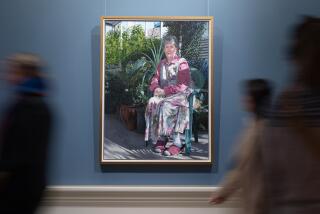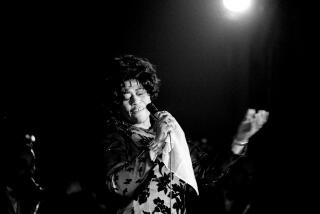Forever Young
- Share via
“At that moment,” F. Scott Fitzgerald wrote in “Tender Is the Night,” his 1934 novel about the Lost Generation, “the Drivers represented externally the exact furthermost evolution of a class.” That class was the idle rich, and for much of the Drivers’ married life, which played itself out in the ‘20s on the Continent,where they kept a villa in France, Dick and Nicole made one feel that merely being in their presence was “a remarkable experience.” They did this by doing, essentially, nothing; their specialness was created with airs, attitude. Indeed their life was little more than one long blur of morning hangovers, empty afternoons and nightly hopes of giving a “really bad party”--the kind at which “there’s a brawl and seductions and people going home with their feelings hurt.”
As inspiration for the Drivers, Fitzgerald used his friends Gerald and Sara Murphy (to whom he dedicated the novel), a couple so enigmatic in their personalities and colorful in their lifestyle that they became close to--and inspiration for--not only Fitzgerald but also other members of the Lost Generation, among them Pablo Picasso, Ernest Hemingway, Archibald MacLeish, John Dos Passos, Robert Benchley and Dorothy Parker. The Roaring ‘20s were defined in America by Prohibition, a rise in organized crime, flappers and a robust economy that created great wealth for some. Because Paris was seen as a cultural center and because the dollar was strong throughout the continent, expatriates--as exemplified by Fitzgerald and Hemingway and who became a “lost” generation of artists--fled to Europe. In “Everybody Was So Young,” her exhaustively researched and brilliantly rendered biography, Amanda Vaill documents how by doing what they did best--by “living well,” as Calvin Tomkins described it in his famous New Yorker profile of the couple, “Living Well Is the Best Revenge”--the Murphys became “godparents” to the Lost Generation.
Sara was one of three daughters born to Frank and Adeline Wiborg. A multimillionaire businessman who in 1895 began buying large parcels of property in East Hampton, Frank Wiborg was a friend of Patrick Murphy, the owner of the Mark Cross Co., the leather goods retailer specializing in luggage and handbags, and whose youngest son was Gerald. Sara and Gerald knew each other for years through family connections before they fell in love and married in 1916. Sara was stunning, sophisticated; among friends, she was known for wearing a simple strand of pearls at all times, even when she was swimming. Gerald was good looking, soft-spoken; at Yale, where he was elected to the exclusive fraternity Skull and Bones, he counted Cole Porter among his friends.
Together, Sara and Gerald made the perfect couple--an ideal pairing from two families in New York’s social elite. Making their home in Manhattan, they had one daughter, Honoria, and two sons, Baoth and Patrick. Then, in the autumn of 1921, with their children in tow, the Murphys traveled to Paris--like so many others, they moved there because the cost of living was extremely low--where they remained, excluding trips to London and summers spent on the French Riviera, until 1925. That year, they moved into Villa America, an estate they bought in Antibes near Cannes that would remain their home for the next several years.
During the Murphys’ years in France, Gerald dabbled in painting, turning out canvases influenced by Picasso, but mostly he played host to an ever-changing collection of writers and artists with whom he and Sara became friends. Parties, dinners, trips to the country, outings at the beach--all were a part of the tasteful, affluent lifestyle the Murphys maintained for themselves and for their friends.
Sometimes, Sara was more than a host. A subject of Picasso, who depicted her nude, she probably had an affair with the artist, although evidence is not conclusive; clearly, she had the opportunity and, judging from his paintings, Picasso had the desire. Fitzgerald, whom the Murphys had met in New York through friends, was “sentimentally disturbed by Sara,” according to Gerald, who believed the author was in love with Sara’s “directness and frankness,” traits lacking in Zelda; Sara did not reciprocate Fitzgerald’s affection since she found his pretty-boy looks off-putting. Hemingway was, to quote his first wife, Hadley, “the kind of man to whom men, women, children and dogs were attracted”--and Sara was no exception; after flirting with each other for years, Sara and Hemingway had a brief but intense affair.
As for Gerald, even though he had an active sex life early on in his marriage, he eventually lost interest in Sara physically, prompting some to speculate that he was homosexual. He in fact once described his attraction to men in a letter to MacLeish as a defect. “My terms of life have been simple,” Murphy wrote. “I have refused to meet it on the grounds of my own defects, for the reason that I have bitterly resented those defects since I was 15 years of age.” According to Vaill, Fitzgerald had unfulfilled homosexual longings; indeed Vaill contends that the story Fitzgerald “was afraid to tell was the [one] of his own romantic--not sexual, but romantic--attraction for Gerald Murphy.” If Gerald had homosexual affairs--and, according to Vaill, it is more than likely he did--they are not a matter of record.
During the fall of 1928 and the spring of 1929, the Murphys lived in Hollywood while Gerald worked as a scenic designer and music consultant on King Vidor’s “Hallelujah!” During their stay, their son Patrick contracted tuberculosis, which then was a fatal disease. With her son sick, Sara devoted herself to his care, often spending weeks with him in Switzerland, where doctors committed him to a sanitarium. At the same time, Gerald fell into a state of self-doubt and depression culminating in a breakdown. This prompted him to quit painting because, as he told Lillian Hellman, “I never believed I was any good.” It was three years before doctors allowed Patrick to return home.
In December 1934, as the Mark Cross Co. floundered in the wake of the 1929 stock market crash, Gerald, his would-be career as an artist abandoned and his father dead, assumed control of the family business. No sooner had the Murphys relocated to New York than Patrick suffered a relapse. Then, while Patrick was hospitalized, Baoth got a case of measles that turned into double mastoiditis; in surgery for that illness, he developed meningitis and died on March 17, 1935. Not quite two years later, Patrick succumbed to tuberculosis. “The golden bowl is broken indeed,” Fitzgerald wrote to his friends, “but it was golden; nothing can ever take those boys away from you now.”
It was at this point that the seasons of parties ended. In the coming years, the Murphys entertained and traveled, but after enduring the worst tragedy a parent can imagine--twice--they could not carry on with the same hospitality, the same social abandon, that had let them preside over an era Fitzgerald once described as “1000 parties but no work.” The Murphys would see themselves depicted in Hemingway’s “The Snows of Kilimanjaro” and “A Moveable Feast,” Dos Passos’ “The Big Money,” MacLeish’s Broadway play “J.B.,” not to mention the 1962 film version of “Tender Is the Night.” Generally, they disliked the way they were portrayed in these works; Sara had hated “Tender Is the Night,” and Gerald described “ A Moveable Feast” as a work revealing “a strange kind of bitterness.” They would witness the destruction of Fitzgerald (of a heart attack caused by years of drinking in 1940) and then Zelda (in a hospital fire in 1948), and they would endure the horror of Hemingway’s suicide by shotgun in 1962. But nothing compared to that interval in the middle of the ‘30s when they watched their sons die.
Ultimately, despite Gerald’s dabbling in painting, the Murphys did not create art in the same way so many of their friends did. In fact, as a subtext to part of her book, Vaill has infused a “what if” quality. What would have happened if Gerald had dealt with his homosexuality? How would Sara’s life have been altered--and Hemingway’s for that matter--if “he had allowed their affair to bloom into a full-fledged romance?” Instead, the Murphys retreated into the safety of their money, where they were protected from society at large and, to a great degree, from themselves. The parties, therefore, were a metaphor: Escape into celebration instead of dealing with the real issues of life. It was not until the deaths of their sons that the realities of life--and death--finally took over.
Gerald died of cancer in 1964; Sara of pneumonia in 1974. As it turned out, the lives the Murphys did lead are fascinating enough, as evidenced by Vaill’s readable and engrossing biography. During the 1920s, they were the beautiful couple who reigned over much of the social scene in Paris and on the French Riviera. In this era of high romance, they epitomized, with their looks and breeding and money, the romantic ideal, the very image of youth. “It wasn’t the parties that made it such a gay time,” Sara once told Tomkins. “There was such affection between everybody. You loved your friends and wanted to see them every day, and usually you did see them every day. It was like a great fair, and everybody was so young.”
More to Read
Sign up for our Book Club newsletter
Get the latest news, events and more from the Los Angeles Times Book Club, and help us get L.A. reading and talking.
You may occasionally receive promotional content from the Los Angeles Times.








